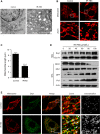Dynamin-related protein 1-mediated mitochondrial fission contributes to IR-783-induced apoptosis in human breast cancer cells
- PMID: 29993201
- PMCID: PMC6111821
- DOI: 10.1111/jcmm.13749
Dynamin-related protein 1-mediated mitochondrial fission contributes to IR-783-induced apoptosis in human breast cancer cells
Erratum in
-
Corrigendum.J Cell Mol Med. 2022 Jun;26(11):3309-3310. doi: 10.1111/jcmm.17363. J Cell Mol Med. 2022. PMID: 35668048 Free PMC article. No abstract available.
Abstract
IR-783 is a kind of heptamethine cyanine dye that exhibits imaging, cancer targeting and anticancer properties. A previous study reported that its imaging and targeting properties were related to mitochondria. However, the molecular mechanism behind the anticancer activity of IR-783 has not been well demonstrated. In this study, we showed that IR-783 inhibits cell viability and induces mitochondrial apoptosis in human breast cancer cells. Exposure of MDA-MB-231 cells to IR-783 resulted in the loss of mitochondrial membrane potential (MMP), adenosine triphosphate (ATP) depletion, mitochondrial permeability transition pore (mPTP) opening and cytochrome c (Cyto C) release. Furthermore, we found that IR-783 induced dynamin-related protein 1 (Drp1) translocation from the cytosol to the mitochondria, increased the expression of mitochondrial fission proteins mitochondrial fission factor (MFF) and fission-1 (Fis1), and decreased the expression of mitochondrial fusion proteins mitofusin1 (Mfn1) and optic atrophy 1 (OPA1). Moreover, knockdown of Drp1 markedly blocked IR-783-mediated mitochondrial fission, loss of MMP, ATP depletion, mPTP opening and apoptosis. Our in vivo study confirmed that IR-783 markedly inhibited tumour growth and induced apoptosis in an MDA-MB-231 xenograft model in association with the mitochondrial translocation of Drp1. Taken together, these findings suggest that IR-783 induces apoptosis in human breast cancer cells by increasing Drp1-mediated mitochondrial fission. Our study uncovered the molecular mechanism of the anti-breast cancer effects of IR-783 and provided novel perspectives for the application of IR-783 in the treatment of breast cancer.
Keywords: Drp1; IR-783; apoptosis; breast cancer; mitochondrial fission.
© 2018 The Authors. Journal of Cellular and Molecular Medicine published by John Wiley & Sons Ltd and Foundation for Cellular and Molecular Medicine.
Figures





References
-
- Zhang B, Wang H, Shen S, et al. Fibrin‐targeting peptide CREKA‐conjugated multi‐walled carbon nanotubes for self‐amplified photothermal therapy of tumor. Biomaterials. 2016;79:46‐55. - PubMed
-
- Deng K, Li C, Huang S, et al. Recent progress in near infrared light triggered photodynamic therapy. Small. 2017;13:1702299. - PubMed
-
- Tobis S, Knopf JK, Silvers CR, et al. Near infrared fluorescence imaging after intravenous indocyanine green: initial clinical experience with open partial nephrectomy for renal cortical tumors. Urology. 2012;79:958‐964. - PubMed
Publication types
MeSH terms
Substances
LinkOut - more resources
Full Text Sources
Other Literature Sources
Medical
Research Materials
Miscellaneous

